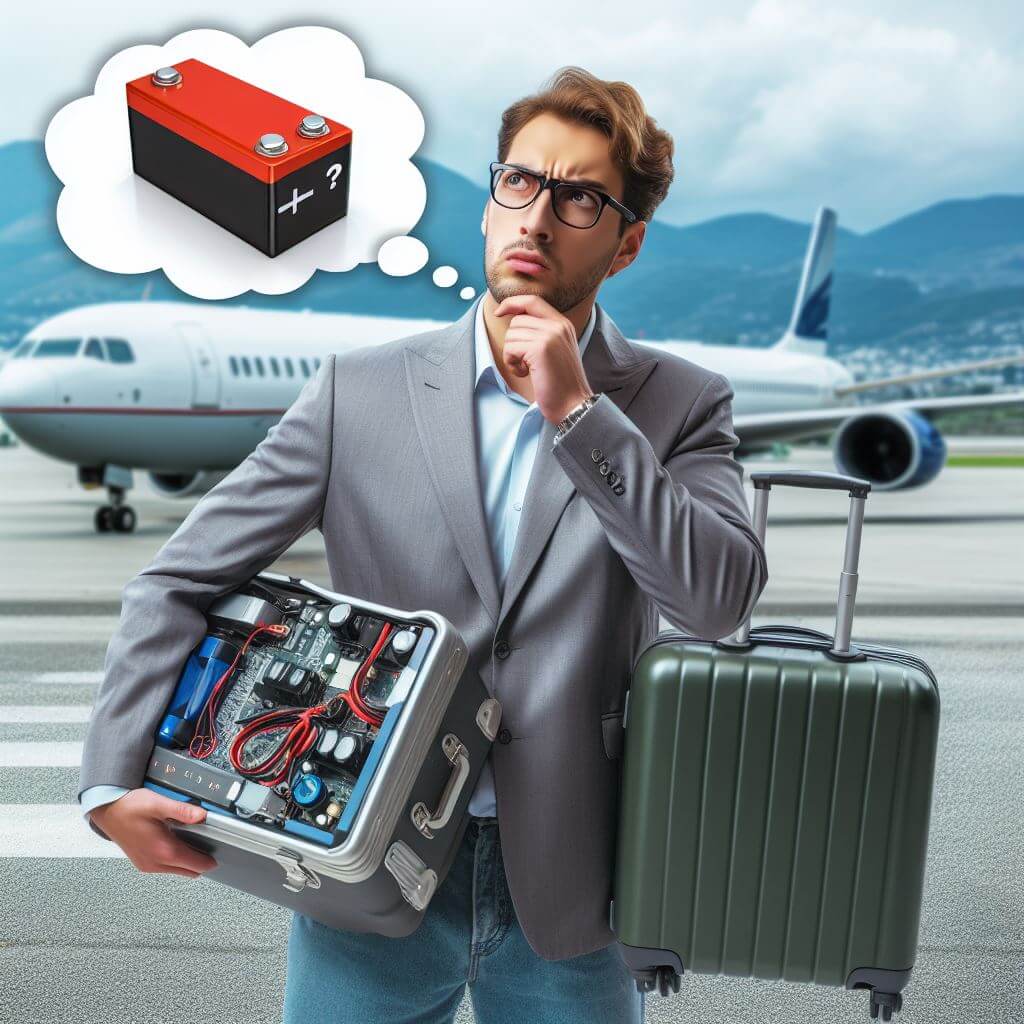Soaring Safe: Unveiling the Mystery of Lithium Batteries and Air Travel
Flickering screens illuminate your adventure plans, headphones hum your pre-flight soundtrack, and a power bank nestles in your bag, ready to refuel your digital journey. But a question stirs beneath the excitement: Are lithium batteries safe for travel?

These ubiquitous energy powerhouses fuel our portable world, but whispers of hidden risks swirl around their compact power. Fear not, intrepid voyager! This blog is your flight log through the often-murky waters of lithium battery travel regulations. We’ll decipher the code, unveil the “safe to fly” secrets, and equip you with the knowledge to soar confidently with your tech companions.
From smartphones and laptops to cameras and headphones, lithium batteries have revolutionized travel, freeing us from tangled cords and forgotten chargers. But their immense energy potential demands responsible handling, both for our safety and the smooth operation of air travel.
This guide will be your trusted pilot, steering you through the essentials of packing, navigating security checks, and understanding the nuanced world of lithium battery regulations. We’ll dispel myths, reveal helpful tips, and ensure you embark on your next adventure with the confidence of a seasoned traveler, all while ensuring your precious tech gadgets reach their destination alongside you.
So, buckle up and prepare for takeoff! Get ready to transform that lingering question – “Are lithium batteries safe for travel?” – into a resounding “Yes, I’m a pro at packing them safely!” Let’s dive into the fascinating world of lithium batteries and air travel, ensuring your journey is powered by knowledge and fueled by adventure.
Decoding the Jargon: Unpacking the Meaning of “Lithium Batteries and Air Travel”

We’ve established that lithium batteries power our wanderlust, but before we pack them with gusto, let’s demystify the terms that govern their journey through the clouds. Fear not, language wizards! This section is your Rosetta Stone, translating the cryptic world of lithium battery regulations into plain English.
Lithium batteries:
These versatile powerhouses come in two main types – lithium-ion (Li-ion) and lithium metal. Li-ion dominate the portable tech scene, powering your phone, laptop, and headphones. Lithium metal batteries tend to be found in larger industrial applications.
Watt-hours (Wh):
This unit measures a battery’s energy storage capacity. It’s like the fuel gauge for your tech gadgets. Remember, the higher the Wh rating, the more powerful (and potentially riskier) the battery.
Spare batteries:
These are batteries not installed in a device, like power banks and spare laptop batteries. While convenient, they have stricter regulations compared to batteries powering your gadgets.
Carry-on luggage:
This is your sacred space for lithium-powered companions. Checked baggage, with its unpredictable handling, is generally a no-go zone for these miniature energy bundles.
Airline regulations:
Each airline has specific guidelines for lithium batteries, varying slightly in limitations and exceptions. It’s your responsibility to check your chosen airline’s rules before packing.
Now, let’s decipher the crux of the matter: are lithium batteries safe for travel? The answer is nuanced. When packed and transported according to regulations, Li-ion batteries with 100 Wh or less, installed in your devices, are generally considered safe. Think smartphones, laptops, cameras, and headphones – your everyday travel tech squad.
However, for more potent batteries or loose power banks, the rules get stricter. We’ll explore these nuances and practical packing tips in the next section, “Full Story,” where we’ll transform you from a travel novice to a lithium battery packing pro!
Get ready to navigate the world of regulations with confidence and unlock the secrets to safe and hassle-free air travel with your trusty tech companions.
Power Your Adventures, Not Anxieties: Navigating the Lithium Labyrinth
Now that we speak the language of lithium batteries and air travel, let’s embark on the practical journey of packing them for your next adventure. Remember, knowledge is power, and when it comes to these miniature energy sources, packing smart ensures a smooth and anxiety-free flight.

The Golden Rule: Lithium batteries with 100 Wh or less, nestled in your devices, are your worry-free travel companions. Smartphones, laptops, tablets, cameras, and headphones – pack them with confidence and enjoy in-flight entertainment powered by their inherent juice.
High-Wattage Heroes (101-160 Wh):
Do you carry a laptop with an extended battery or a professional camera with a hefty power pack? Fear not, high-wattage adventurers! You can still bring these energy champs, but with a little extra planning.
- Prior Approval: Contact your chosen airline well in advance and seek permission to bring these higher-wattage batteries. Each airline has specific limits and procedures, so be proactive and avoid last-minute stress.
- Protective Packaging: Treat these batteries like VIPs! Pack them individually in strong, protective cases to prevent short circuits or damage. Think sturdy containers or manufacturer-provided packaging.
- Label with Love: Clarity is key! Clearly label each high-wattage battery with its Wh rating to expedite security checks. Remember, transparency keeps the air travel gods happy.
Spare Battery Squad:
Power banks, extra laptop batteries, the unsung heroes of tech-fueled wanderlust. But for these independent power sources, the rules tighten.
- Carry-on Companions: No matter their Wh rating, all spare batteries must reside in your carry-on luggage. Checked baggage is a no-go zone for these unattached energy reserves.
- Quantity Counts: Airlines dictate the number of spare batteries you can bring. Generally, you can pack up to two spare batteries below 100 Wh and one between 100 and 160 Wh. Check your airline’s specific guidelines for precise limitations.
- Damage Detective: Before packing, inspect your spare batteries for any signs of damage, cracks, or leaks. Damaged batteries are a safety hazard and will be confiscated at security. Remember, a stitch in time (or a good pre-packing check) saves you from disappointment at the airport.
Bonus Tip:
Pack your power bank with a lower charge (ideally below 70%) to avoid raising any red flags at security. Think of it as extending a courtesy to the friendly folks keeping the skies safe.
Remember, these are just the general guidelines. Always double-check the regulations of your specific airline and destination country. Websites like the Transportation Security Administration (TSA) and Federal Aviation Administration (FAA) offer detailed information and downloadable charts to make packing a breeze.
By following these tips and regulations, you can ensure your lithium batteries travel safely and seamlessly, allowing you to focus on the exciting adventures that await! Now, before we prepare for takeoff, let’s address some frequently asked questions and equip you with all the knowledge needed for a confident and informed air travel experience.
Bon Voyage with Batteries: Conclusion & FAQs for a Safe and Informed Journey
We’ve charted the course through the lithium battery labyrinth, equipping you with the knowledge and power to pack smart and soar confidently with your tech companions. Now, before you embark on your next adventure, let’s address some burning questions and ensure your journey is fueled by both excitement and peace of mind:
FAQs:
Q: Can I bring my vape device on board?
A: Unfortunately, most airlines prohibit vaping devices due to their lithium batteries and potential fire risk. Always check your airline’s specific policy before packing.
Q: What happens if I accidentally bring a prohibited battery?
A: If your lithium batteries exceed the allowed limits or are not packed according to regulations, they may be confiscated at security. In some cases, you may face fines or delays. Proactive planning and thorough checks are key to avoiding such inconveniences.
Q: Where can I find more information about lithium battery regulations?
A: Excellent resources include the websites of the Transportation Security Administration (TSA) and the Federal Aviation Administration (FAA). They offer detailed guidelines, downloadable charts, and FAQs to keep you informed. Remember, knowledge is power – and in this case, it translates to a smooth and hassle-free flight.
Q: Do I need to worry about lithium batteries overheating in checked baggage?
A: While the risk of overheating is lower in checked baggage due to controlled temperature conditions, it’s still best practice to follow the “spare battery in carry-on” rule for all lithium batteries regardless of Wh rating. Remember, safety first!
Conclusion:
So, are lithium batteries safe for travel? The answer is a resounding yes when packed and transported according to regulations. By embracing knowledge, prioritizing safe packing practices, and respecting airline guidelines, you can ensure your tech gadgets become travel companions, not travel anxieties.
Let this blog be your compass as you navigate the world of lithium batteries and air travel. Pack smart, fly informed, and most importantly, embrace the exhilarating adventures that await, powered by the magic of technology and fueled by the wisdom of responsible travel. Bon voyage!
Remember, even with this comprehensive guide, checking your specific airline’s regulations and staying updated on any changes is crucial. By combining the information in this blog with official airline guidelines, you can confidently chart your course through the sky, ensuring your travel experience is fueled by excitement, not battery stress.
Happy travels!
Leave a Reply